Effect of Different Surface Designs on the Rotational Resistance and Stability of Orthodontic Miniscrews: A Three-Dimensional Finite Element Study
Abstract
1. Introduction
2. Materials and Methods
2.1. Development of Finite Element Model
2.2. Modification of Miniscrew Design
2.3. Force Loading Conditions
2.4. Statistical Analysis
3. Results
3.1. Von-Mises Stress
3.1.1. Bone versus Orthodontic Miniscrew
3.1.2. Area of the Orthodontic Miniscrew
3.1.3. Modification of the Surface of the Orthodontic Miniscrew
3.2. Moment Required to Unwind the Orthodontic Miniscrew
3.2.1. Overall Moment
3.2.2. Moment at the Cortical Bone
3.2.3. Moment at the Trabecular Bone
4. Discussion
5. Conclusions
6. Patents
Author Contributions
Funding
Institutional Review Board Statement
Informed Consent Statement
Data Availability Statement
Acknowledgments
Conflicts of Interest
References
- Antoszewska-Smith, J.; Sarul, M.; Łyczek, J.; Konopka, T.; Kawala, B. Effectiveness of orthodontic miniscrew implants in anchorage reinforcement during en-masse retraction: A systematic review and meta-analysis. Am. J. Orthod. Dentofacial. Orthop. 2017, 151, 440–455. [Google Scholar] [CrossRef]
- Sosly, R.; Mohammed, H.; Rizk, M.Z.; Jamous, E.; Qaisi, A.G.; Bearn, D.R. Effectiveness of miniscrew-supported maxillary incisor intrusion in deep-bite correction: A systematic review and meta-analysis. Angle Orthod. 2020, 90, 291–304. [Google Scholar] [CrossRef]
- Alsafadi, A.S.; Alabdullah, M.M.; Saltaji, H.; Abdo, A.; Youssef, M. Effect of molar intrusion with temporary anchorage devices in patients with anterior open bite: A systematic review. Prog. Orthod. 2016, 17, 9. [Google Scholar] [CrossRef]
- Morita, Y.; Koga, Y.; Nguyen, T.A.; Yoshida, N. Biomechanical considerations for uprighting impacted mandibular molars. Korean J. Orthod. 2020, 50, 268–277. [Google Scholar] [CrossRef]
- Park, J.J.; Park, Y.C.; Lee, K.J.; Cha, J.Y.; Tahk, J.H.; Choi, Y.J. Skeletal and dentoalveolar changes after miniscrew-assisted rapid palatal expansion in young adults: A cone-beam computed tomography study. Korean J. Orthod. 2017, 47, 77–86. [Google Scholar] [CrossRef] [PubMed]
- Papageorgiou, S.N.; Zogakis, I.P.; Papadopoulos, M.A. Failure rates and associated risk factors of orthodontic miniscrew implants: A meta-analysis. Am. J. Orthod. Dentofacial. Orthop. 2012, 142, 577–595.e7. [Google Scholar] [CrossRef] [PubMed]
- Ren, B.; Wan, Y.; Liu, C.; Wang, H.; Yu, M.; Zhang, X.; Huang, Y. Improved osseointegration of 3D printed Ti-6Al-4V implant with a hierarchical micro/nano surface topography: An in vitro and in vivo study. Mater. Sci. Eng. C Mater. Biol. Appl. 2021, 118, 111505. [Google Scholar] [CrossRef] [PubMed]
- Wang, L.; Gao, Z.; Su, Y.; Liu, Q.; Ge, Y.; Shan, Z. Osseointegration of a novel dental implant in canine. Sci. Rep. 2021, 11, 4317. [Google Scholar] [CrossRef]
- Carlsson, L.; Röstlund, T.; Albrektsson, B.; Albrektsson, T.; Brånemark, P.I. Osseointegration of titanium implants. Acta Orthop. Scand. 1986, 57, 285–289. [Google Scholar] [CrossRef]
- Kim, H.K.; Lee, E.Y.; Kim, J.J. Five-year retrospective radiographic follow-up study of dental implants with sandblasting with large grit, and acid etching-treated surfaces. J. Korean Assoc. Oral Maxillofac. Surg. 2015, 41, 317–321. [Google Scholar] [CrossRef]
- NemŢoi, A.; Trandafir, V.; Paşca, A.S.; Şindilar, E.V.; Drăgan, E.; Odri, G.A.; NemŢoi, A.; Haba, D.; Şapte, E. Osseointegration of chemically modified sandblasted and acid-etched titanium implant surface in diabetic rats: A histological and scanning electron microscopy study. Rom. J. Morphol. Embryol. 2017, 58, 881–886. [Google Scholar]
- Kim, J.S.; Kang, S.M.; Seo, K.W.; Nahm, K.Y.; Chung, K.R.; Kim, S.H.; Ahn, J.P. Nanoscale bonding between human bone and titanium surfaces: Osseohybridization. BioMed Res. Int. 2015, 2015, 960410. [Google Scholar] [CrossRef] [PubMed]
- Bousquet, F.; Bousquet, P.; Mauran, G.; Parguel, P. Use of an impacted post for anchorage. J. Clin. Orthod. 1996, 30, 261–265. [Google Scholar] [PubMed]
- Kanomi, R. Mini-implant for orthodontic anchorage. J. Clin. Orthod. 1997, 31, 763–767. [Google Scholar] [PubMed]
- Costa, A.; Raffainl, M.; Melsen, B. Miniscrews as orthodontic anchorage: A preliminary report. Int. J. Adult Orthodon. Orthognath. Surg. 1998, 13, 201–209. [Google Scholar]
- Umemori, M.; Sugawara, J.; Mitani, H.; Nagasaka, H.; Kawamura, H. Skeletal anchorage system for open-bite correction. Am. J. Orthod. Dentofacial. Orthop. 1999, 115, 166–174. [Google Scholar] [CrossRef]
- De Clerck, H.; Geerinckx, V.; Siciliano, S. The Zygoma Anchorage System. J. Clin. Orthod. 2002, 36, 455–459. [Google Scholar]
- Lindhe, J.; Lang, N.P.; Karring, T. Clinical Periodontology and Implant Dentistry, 5th ed.; Blackwell Publishing Ltd.: Oxford, UK, 2008; Volume 2. [Google Scholar]
- Vannet, B.V.; Sabzevar, M.M.; Wehrbein, H.; Asscherickx, K. Osseointegration of miniscrews: A histomorphometric evaluation. Eur. J. Orthod. 2007, 29, 437–442. [Google Scholar] [CrossRef]
- Kim, S.H.; Kook, Y.A.; Jeong, D.M.; Lee, W.; Chung, K.R.; Nelson, G. Clinical application of accelerated osteogenic orthodontics and partially osseointegrated mini-implants for minor tooth movement. Am. J. Orthod. Dentofacial. Orthop. 2009, 1316, 431–439. [Google Scholar] [CrossRef] [PubMed]
- Kim, J.S.; Ahn, J.P.; Kim, Y.H.; Seo, K.W.; Zadeh, H.; Kim, S.H. Atomic layout of an orthodontic titanium mini-implant in human tissue: Insights into the possible mechanisms during osseointegration. Angle Orthod. 2019, 89, 292–298. [Google Scholar] [CrossRef]
- Mo, S.S.; Kim, S.H.; Sung, S.J.; Chung, K.R.; Chun, Y.S.; Kook, Y.A.; Nelson, G. Factors controlling anterior torque during C-implant-dependent en-masse retraction without posterior appliances. Am. J. Orthod. Dentofacial. Orthop. 2011, 140, 72–80. [Google Scholar] [CrossRef]
- Smeets, R.; Stadlinger, B.; Schwarz, F.; Beck-Broichsitter, B.; Jung, O.; Precht, C.; Kloss, F.; Gröbe, A.; Heiland, M.; Ebker, T. Impact of dental implant surface modifications on osseointegration. BioMed Res. Int. 2016, 2016, 6285620. [Google Scholar] [CrossRef]
- Schünemann, F.H.; Galárraga-Vinueza, M.E.; Magini, R.; Fredel, M.; Silva, F.; Souza, J.C.M.; Zhang, Y.; Henriques, B. Zirconia surface modifications for implant dentistry. Mater. Sci. Eng. C Mater. Biol. Appl. 2019, 87, 1294–1305. [Google Scholar] [CrossRef]
- Yücesoy, T.; Seker, E.D.; Cenkcı, E.; Yay, A.; Alkan, A. Histologic and Biomechanical Evaluation of Osseointegrated Miniscrew Implants Treated with Ozone Therapy and Photobiomodulation at Different Loading Times. Int. J. Oral Maxillofac. Implants 2019, 34, 1337–1345. [Google Scholar] [CrossRef] [PubMed]
- Rampurawala, A.H.; Patil, A.S.; Bhosale, V.I. Bone-miniscrew contact and surface element deposition on orthodontic miniscrews after ultraviolet photofunctionalization. Int. J. Oral. Maxillofac. Implants 2020, 35, 1090–1097. [Google Scholar] [CrossRef] [PubMed]
- Mo, S.S.; Kim, S.H.; Sung, S.J.; Chung, K.R.; Chun, Y.S.; Kook, Y.A.; Nelson, G. Factors controlling anterior torque with C-implants depend on en-masse retraction without posterior appliances: Biocreative therapy type II technique. Am. J. Orthod. Dentofacial. Orthop. 2011, 139, e183–e191. [Google Scholar] [CrossRef] [PubMed]
- Mo, S.S.; Noh, M.K.; Kim, S.H.; Chung, K.R.; Nelson, G. Finite element study of controlling factors of anterior intrusion and torque during Temporary Skeletal Anchorage Device (TSAD) dependent en masse retraction without posterior appliances: Biocreative hybrid retractor (CH-retractor). Angle Orthod. 2020, 90, 255–262. [Google Scholar] [CrossRef] [PubMed]
- Granato, R.; Bonfante, E.A.; Castellano, A.; Khan, R.; Jimbo, R.; Marin, C.; Morsi, S.; Witek, L.; Coelho, P.G. Osteointegrative and microgeometric comparison between micro-blasted and alumina blasting/acid etching on grade II and V titanium alloys (Ti-6Al-4V). J. Mech. Behav. Biomed. Mater. 2019, 97, 288–295. [Google Scholar] [CrossRef] [PubMed]
- Lee, J.A.; Ahn, H.W.; Oh, S.H.; Park, K.H.; Kim, S.H.; Nelson, G. Evaluation of interradicular space, soft tissue, and hard tissue of the posterior palatal alveolar process for orthodontic mini-implant, using cone-beam computed tomography. Am. J. Orthod. Dentofacial. Orthop. 2021. [Google Scholar] [CrossRef] [PubMed]
- Brettin, B.T.; Grosland, N.M.; Qian, F.; Southard, K.A.; Stuntz, T.D.; Morgan, T.A.; Marshall, S.D.; Southard, T.E. Bicortical vs monocortical orthodontic skeletal anchorage. Am. J. Orthod. Dentofacial. Orthop. 2008, 134, 625–635. [Google Scholar] [CrossRef]
- Suzuki, A.; Masuda, T.; Takahashi, I.; Deguchi, T.; Suzuki, O.; Takano-Yamamoto, T. Changes in stress distribution of orthodontic miniscrews and surrounding bone evaluated by 3-dimensional finite element analysis. Am. J. Orthod. Dentofacial. Orthop. 2011, 140, e273–e280. [Google Scholar] [CrossRef]
- Miyawaki, S.; Koyama, I.; Inoue, M.; Mishima, K.; Sugahara, T.; Takano-Yamamoto, T. Factors associated with the stability of titanium screws placed in the posterior region for orthodontic anchorage. Am. J. Orthod. Dentofacial. Orthop. 2003, 124, 373–378. [Google Scholar] [CrossRef]
- Ajami, S.; Mina, A.; Nabavizadeh, S.A. Stress distributions of a bracket type orthodontic miniscrew and the surrounding bone under moment loadings: Three-dimensional finite element analysis. J. Orthod. Sci. 2016, 5, 64–69. [Google Scholar] [CrossRef] [PubMed]
- Choi, S.H.; Kim, S.J.; Lee, K.J.; Sung, S.J.; Chun, Y.S.; Hwang, C.J. Stress distributions in peri-miniscrew areas from cylindrical and tapered miniscrews inserted at different angles. Korean J. Orthod. 2016, 46, 189–198. [Google Scholar] [CrossRef][Green Version]
- Berglundh, T.; Abrahamsson, I.; Lang, N.P.; Lindhe, J. De novo alveolar bone formation adjacent to endosseous implants. Clin. Oral Implants Res. 2003, 14, 251–262. [Google Scholar] [CrossRef] [PubMed]
- Kim, S.H.; Cho, J.H.; Chung, K.R.; Kook, Y.A.; Nelson, G. Removal torque values of surface-treateed mini-implants after loading. Am. J. Orthod. Dentofacial. Orthop. 2008, 134, 36–43. [Google Scholar] [CrossRef]
- Kim, S.H.; Lee, S.J.; Cho, I.S.; Kim, S.K.; Kim, T.W. Rotational resistance of surface-treated mini-implants. Angle Orthod. 2009, 79, 899–907. [Google Scholar] [CrossRef] [PubMed]
- Tepedino, M.; Cattaneo, P.M.; Niu, X.; Cornelis, M.A. Interradicular sites and cortical bone thickness for miniscrew insertion: A systematic review with meta-analysis. Am. J. Orthod. Dentofacial. Orthop. 2020, 158, 783–798.e20. [Google Scholar] [CrossRef] [PubMed]
- Pickard, M.B.; Dechow, P.; Rossouw, P.E.; Buschang, P.H. Effects of miniscrew orientation on implant stability and resistance to failure. Am. J. Orthod. Dentofacial. Orthop. 2010, 137, 91–99. [Google Scholar] [CrossRef] [PubMed]
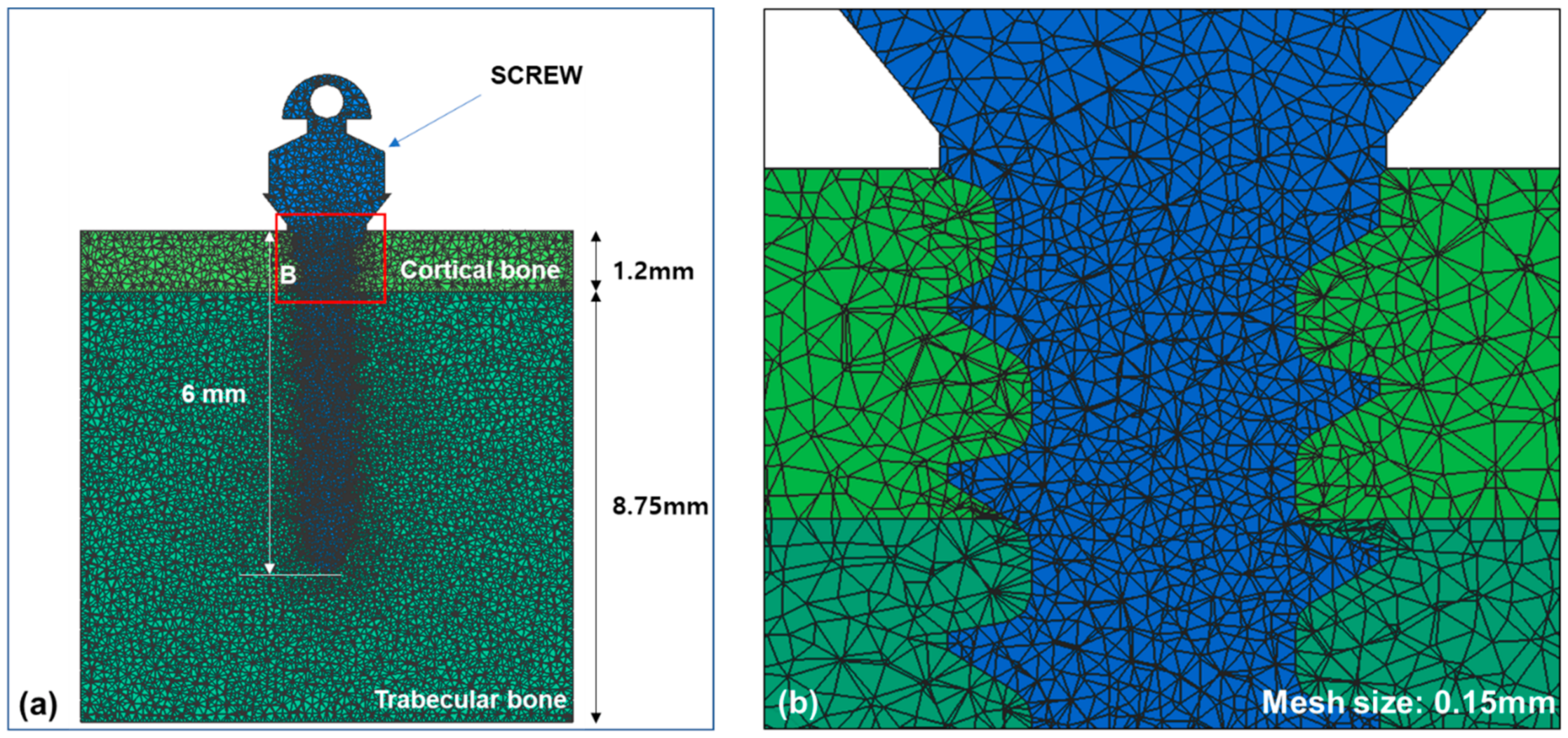



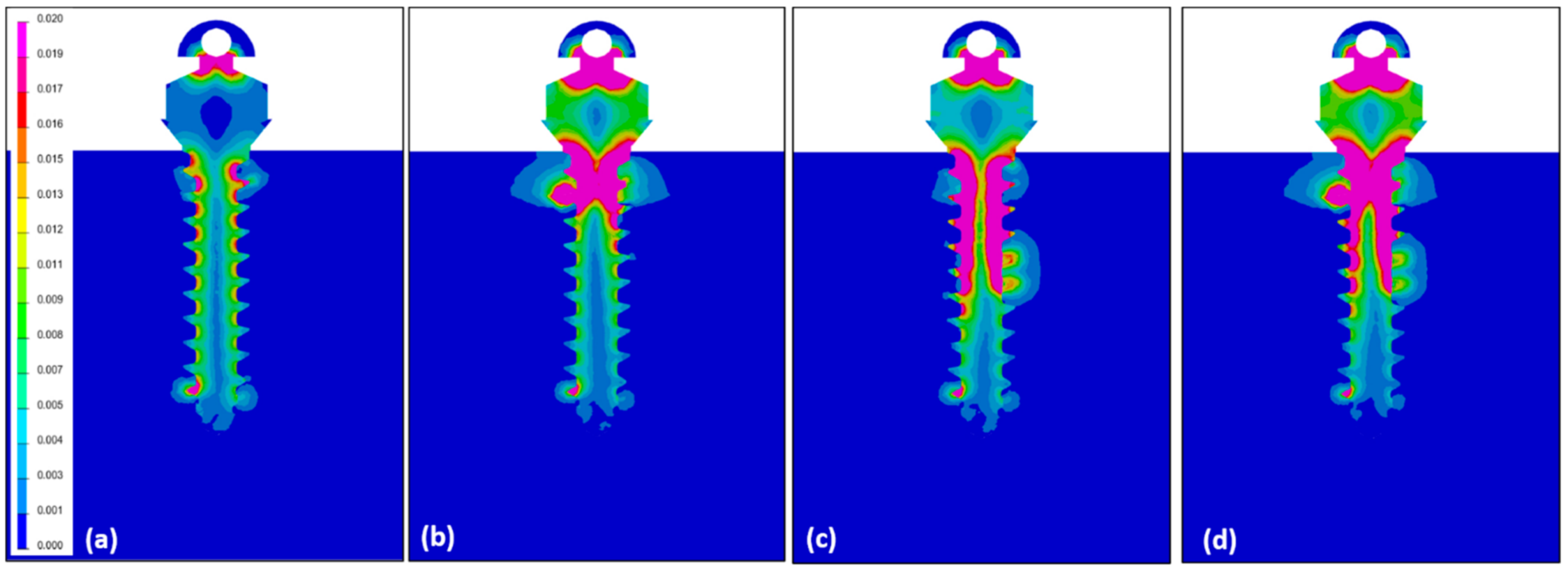
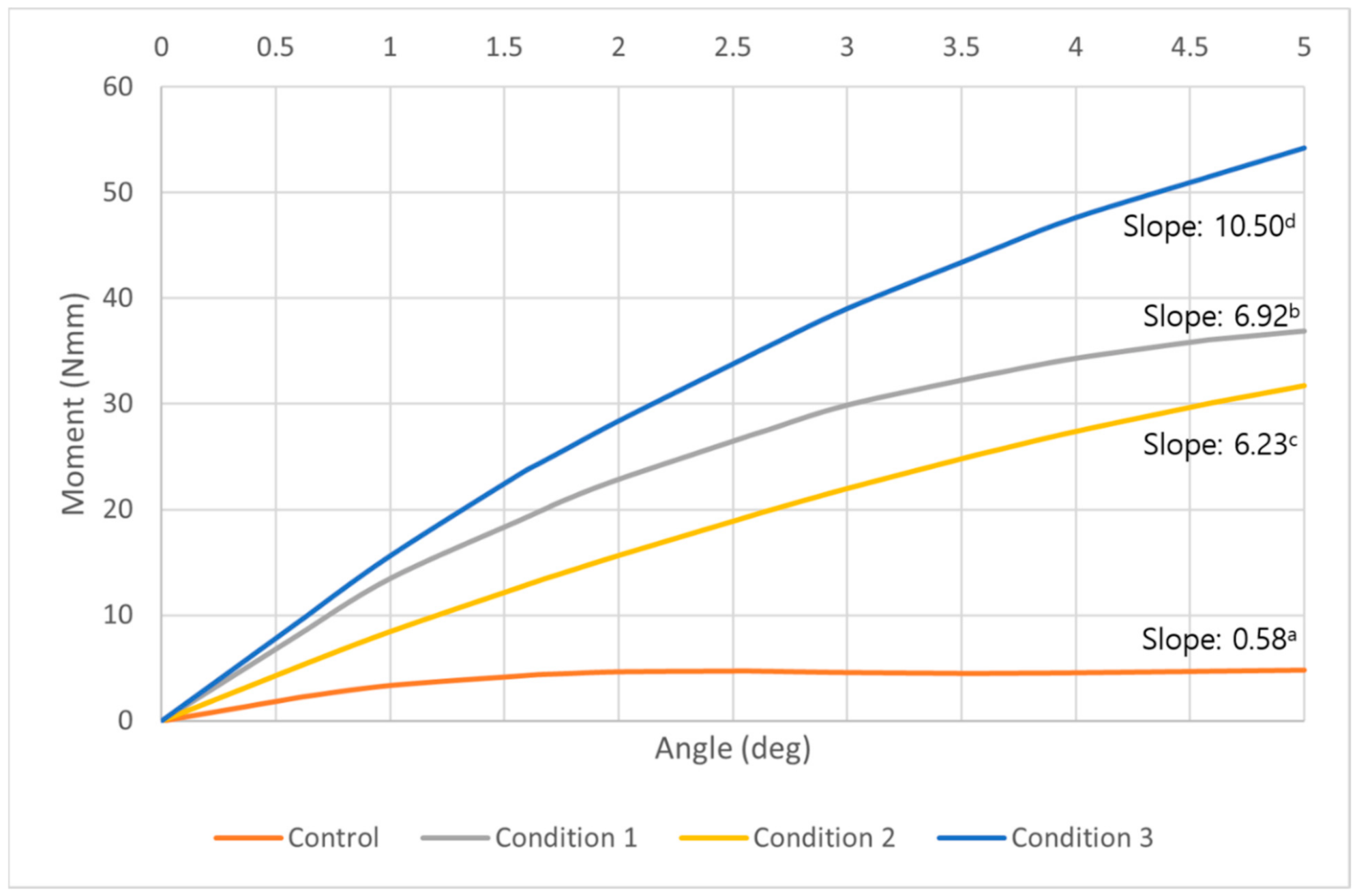
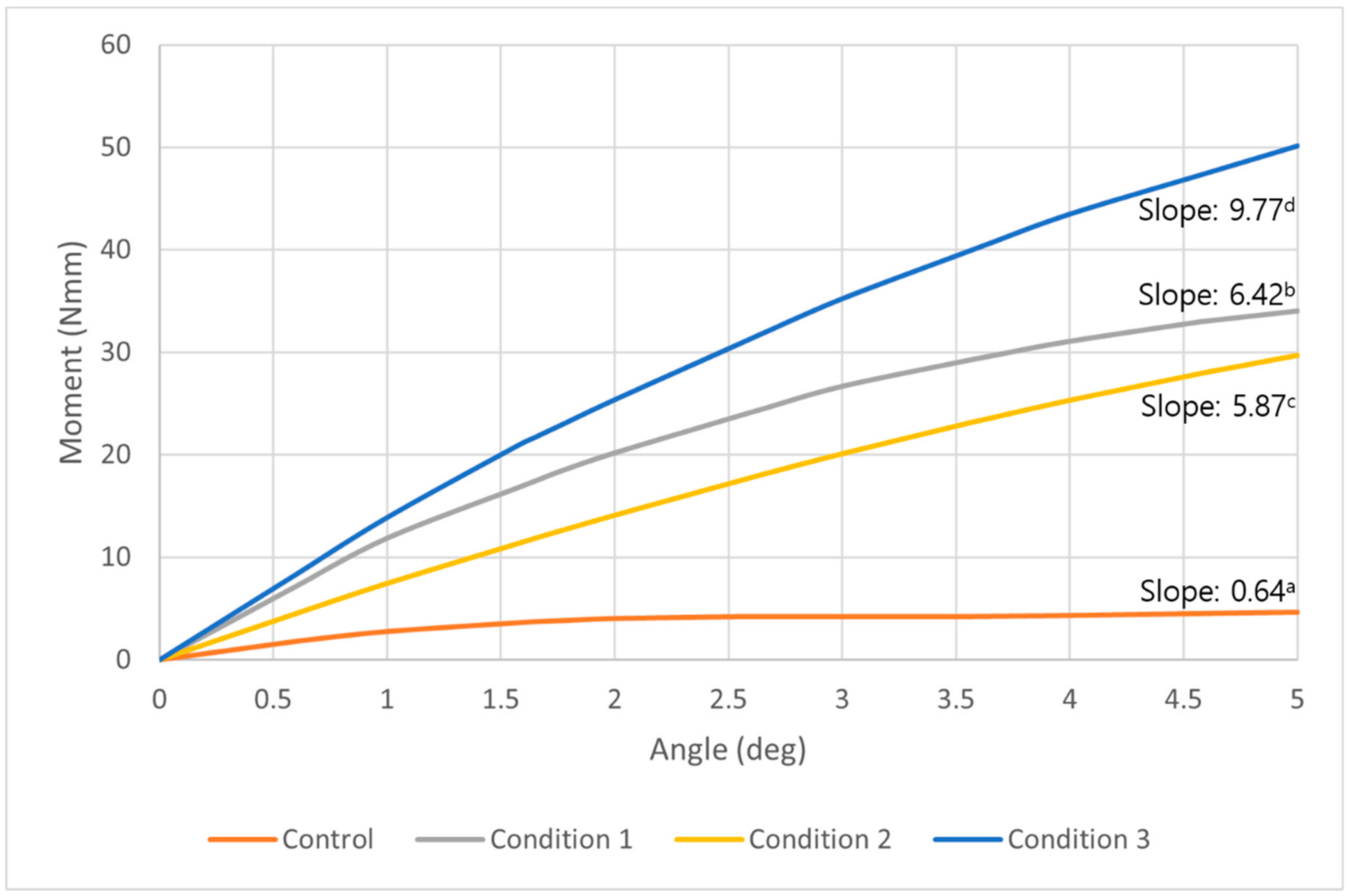

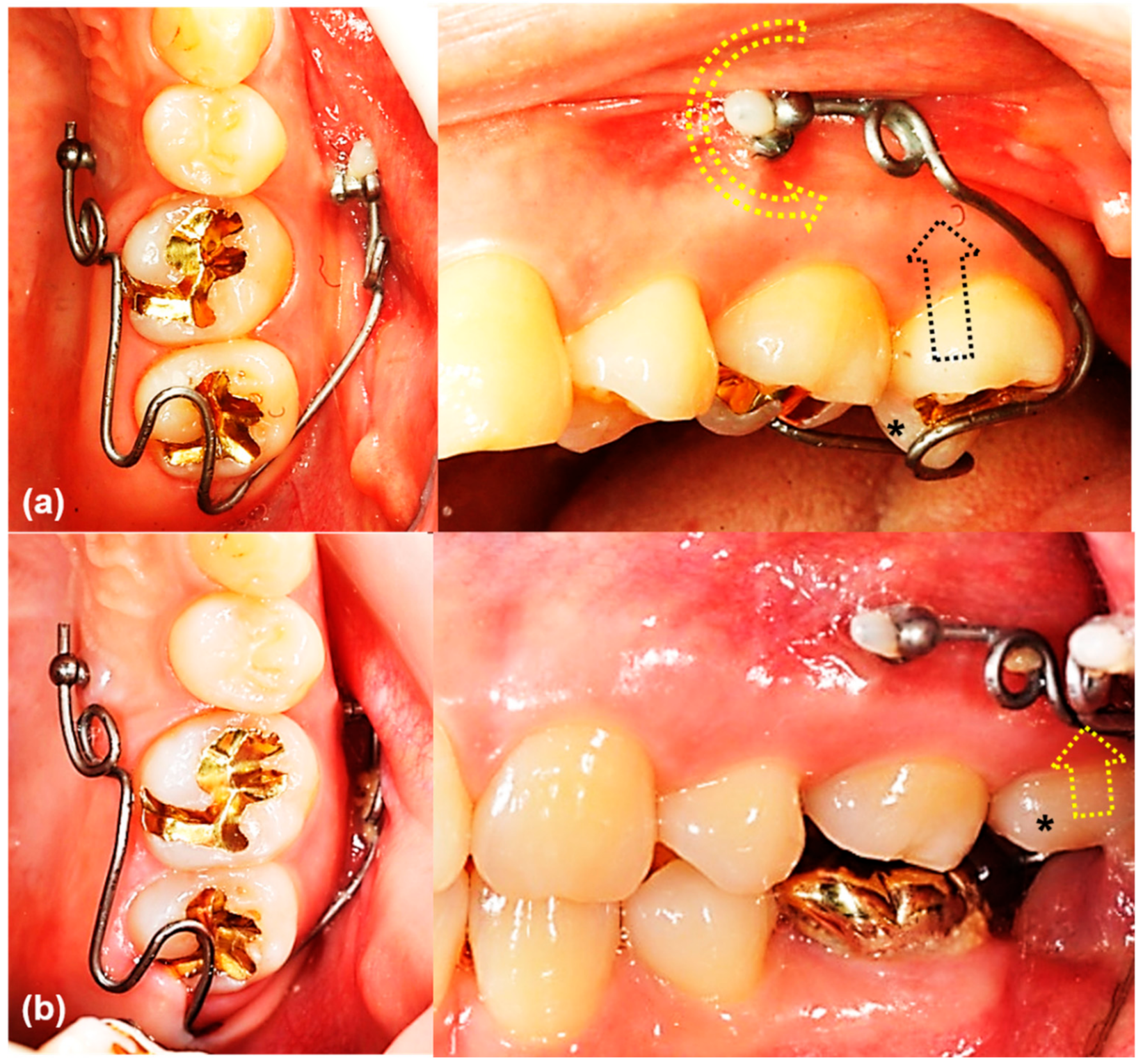

| Young’s Modulus (GPa) | Poisson’s Ratio | |
|---|---|---|
| Cortical bone | 13.7 | 0.3 |
| Trabecular bone | 1.37 | 0.3 |
| Titanium | 110 | 0.35 |
| Bone | Orthodontic Miniscrew | ||||
|---|---|---|---|---|---|
| Overall | Upper 1/3 | Middle 1/3 | Apical 1/3 | ||
| Control | 0.045 | 0.072 | 0.072 | 0.020 | 0.072 |
| Condition 1 | 0.221 | 1.002 | 1.002 | 0.022 | 0.054 |
| Condition 2 | 0.034 | 0.260 | 0.099 | 0.260 | 0.056 |
| Condition 3 | 0.206 | 1.001 | 1.001 | 0.204 | 0.045 |
| Counterclockwise Rotation | Generalized Linear Regression * | ||||||||
|---|---|---|---|---|---|---|---|---|---|
| 1° | 2° | 3° | 4° | 5° | Slope | CI | p-Value | ||
| Control a | 3.34 | 4.62 | 4.55 | 4.53 | 4.78 | 0.58 | 0.35 | 0.81 | <0.0001 |
| Condition 1 b | 13.47 | 22.86 | 29.90 | 34.33 | 36.90 | 6.92 | 6.16 | 7.68 | <0.0001 |
| Condition 2 c | 8.46 | 15.66 | 21.99 | 27.40 | 31.73 | 6.23 | 5.94 | 6.25 | <0.0001 |
| Condition 3 d | 15.61 | 28.38 | 39.01 | 47.62 | 54.21 | 10.50 | 9.85 | 11.15 | <0.0001 |
| Counterclockwise Rotation | Generalized Linear Regression * | ||||||||
|---|---|---|---|---|---|---|---|---|---|
| 1° | 2° | 3° | 4° | 5° | Slope | CI | p-Value | ||
| Control a | 2.80 | 4.07 | 4.23 | 4.35 | 4.65 | 0.64 | 0.45 | 0.83 | <0.0001 |
| Condition 1 b | 11.88 | 20.22 | 26.72 | 31.12 | 34.08 | 6.42 | 5.81 | 7.04 | <0.0001 |
| Condition 2 c | 7.46 | 14.12 | 20.12 | 25.34 | 29.71 | 5.87 | 5.65 | 6.10 | <0.0001 |
| Condition 3 d | 13.90 | 25.41 | 35.30 | 43.60 | 50.31 | 9.77 | 9.26 | 10.29 | <0.0001 |
| Counterclockwise Rotation | Generalized Linear Regression * | ||||||||
|---|---|---|---|---|---|---|---|---|---|
| 1° | 2° | 3° | 4° | 5° | Slope | CI | p-Value | ||
| Control a | 1.59 | 2.78 | 3.60 | 4.26 | 4.69 | 0.88 | 0.80 | 0.96 | <0.0001 |
| Condition 1 a | 1.31 | 2.58 | 3.69 | 4.65 | 5.45 | 1.09 | 1.05 | 1.13 | <0.0001 |
| Condition 2 b | 4.35 | 8.58 | 12.55 | 16.20 | 19.49 | 3.90 | 3.82 | 3.98 | <0.0001 |
| Condition 3 c | 3.18 | 6.65 | 10.15 | 13.59 | 16.89 | 3.43 | 3.41 | 3.45 | <0.0001 |
Publisher’s Note: MDPI stays neutral with regard to jurisdictional claims in published maps and institutional affiliations. |
© 2021 by the authors. Licensee MDPI, Basel, Switzerland. This article is an open access article distributed under the terms and conditions of the Creative Commons Attribution (CC BY) license (http://creativecommons.org/licenses/by/4.0/).
Share and Cite
Choi, J.-Y.; Cho, J.; Oh, S.H.; Kim, S.-H.; Chung, K.-R.; Nelson, G. Effect of Different Surface Designs on the Rotational Resistance and Stability of Orthodontic Miniscrews: A Three-Dimensional Finite Element Study. Sensors 2021, 21, 1964. https://doi.org/10.3390/s21061964
Choi J-Y, Cho J, Oh SH, Kim S-H, Chung K-R, Nelson G. Effect of Different Surface Designs on the Rotational Resistance and Stability of Orthodontic Miniscrews: A Three-Dimensional Finite Element Study. Sensors. 2021; 21(6):1964. https://doi.org/10.3390/s21061964
Chicago/Turabian StyleChoi, Jin-Young, Jaehee Cho, Song Hee Oh, Seong-Hun Kim, Kyu-Rhim Chung, and Gerald Nelson. 2021. "Effect of Different Surface Designs on the Rotational Resistance and Stability of Orthodontic Miniscrews: A Three-Dimensional Finite Element Study" Sensors 21, no. 6: 1964. https://doi.org/10.3390/s21061964
APA StyleChoi, J.-Y., Cho, J., Oh, S. H., Kim, S.-H., Chung, K.-R., & Nelson, G. (2021). Effect of Different Surface Designs on the Rotational Resistance and Stability of Orthodontic Miniscrews: A Three-Dimensional Finite Element Study. Sensors, 21(6), 1964. https://doi.org/10.3390/s21061964







